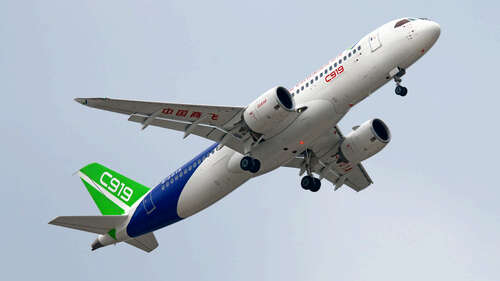
The C919 has a range of 4,075 to 5,555 kilometers (about 2,500 to 3,450 miles) and seats between 158 and 192 passengers in its single-aisle cabin. The fuselage is 38.9 meters (127.6 feet) long, and the C919’s wingspan is 35.8 meters (117.5 feet). The tip of the tail stands 11.95 meters(39.2 feet) from the ground, and the cabin height is 2.25 meters (7.4 feet).
Many of the C919’s components are made outside China, including the wing-mounted CFMI LEAP 1- engines. Most of the aluminum alloy fuselage and wing panels are made in Xi’an and Jiangxi and assembled in Shanghai. The fly-by-wire system, hydraulics, and auxiliary power and fire protection systems are mostly made in the USA by Parker, Honeywell, MOOG, and Kidde, although the Aviation Industry Corporation of China, or AVIC, contributes to those systems as well. Swiss industrial machinery giant Liebherr makes the C919’s landing gear and air conditioning system, the latter of which can be controlled by passengers on a seat-by-seat basis.
The active C919 fleet is currently limited to the four planes operated by China Eastern; the C919 is not yet certified to fly elsewhere. If Comac can clear regulatory hurdles and avoid supply chain disruptions, the C919 could someday put a dent in the market for older passenger aircraft. Industry consultant Mike Yeomans told Reuters, “With Airbus and Boeing narrowbodies sold out for most of this decade, the C919 has a strong opportunity to gain market share, particularly in its domestic market.”

